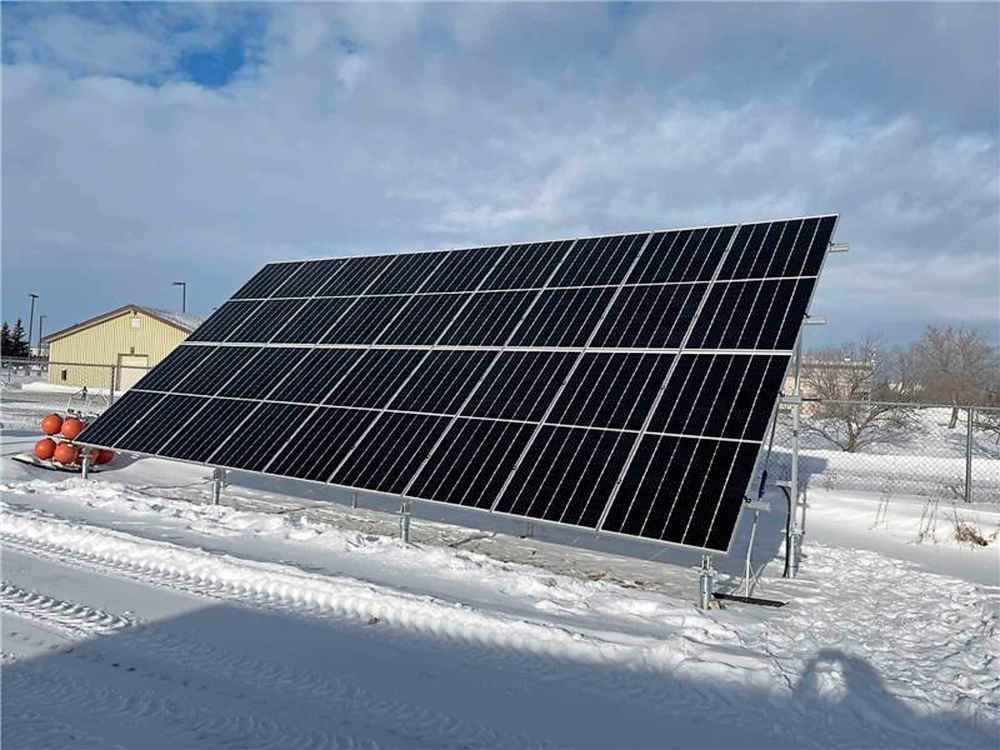U of M sea ice lab turns to solar power
Advertisement
Read this article for free:
or
Already have an account? Log in here »
To continue reading, please subscribe:
Monthly Digital Subscription
$0 for the first 4 weeks*
- Enjoy unlimited reading on winnipegfreepress.com
- Read the E-Edition, our digital replica newspaper
- Access News Break, our award-winning app
- Play interactive puzzles
*No charge for 4 weeks then price increases to the regular rate of $19.00 plus GST every four weeks. Offer available to new and qualified returning subscribers only. Cancel any time.
Monthly Digital Subscription
$4.75/week*
- Enjoy unlimited reading on winnipegfreepress.com
- Read the E-Edition, our digital replica newspaper
- Access News Break, our award-winning app
- Play interactive puzzles
*Billed as $19 plus GST every four weeks. Cancel any time.
To continue reading, please subscribe:
Add Free Press access to your Brandon Sun subscription for only an additional
$1 for the first 4 weeks*
*Your next subscription payment will increase by $1.00 and you will be charged $16.99 plus GST for four weeks. After four weeks, your payment will increase to $23.99 plus GST every four weeks.
Read unlimited articles for free today:
or
Already have an account? Log in here »
Hey there, time traveller!
This article was published 22/01/2025 (317 days ago), so information in it may no longer be current.
A new solar panel designed to power experiments involving sea ice will help the University of Manitoba save cold cash.
The $30,000 solar panel will reduce the hydro bill, plus excess power generated by it can be put on Manitoba Hydro’s grid.
Debbie Armstrong, an instructor in the environment and geography department, who is a technician at the ultra-clean trace elements laboratory, wrote the proposal to acquire the panel.

She said it will pay for itself in 12 years.
“It’s the first solar panel installation on the campus that not only powers the research station, but, if we’re not using it all, the electricity not used goes to the grid.”
She said they expect the solar panel to replace about 27 per cent of the electricity used by all of the monitors and machines which are connected to the university’s Sea-Ice Experimental Research Facility. The facility has a 460,000-litre pool filled with a mix of water and brine to create the same concentration as ocean water.
“We do many experiments there,” said Armstrong. That includes investigating how much light penetrates the ice. “You can do the experiments here without going to Churchill.”
She said the outdoor pool thaws when it’s warmer, so the experiments come to a halt and the scientific equipment is turned off.
“It’s those months when all of the power being generated will go to Manitoba Hydro’s grid,” said Armstrong.
“Our summers are so fantastic — they start in May and go to October. Maybe in a year I will have a better projection on how much power is generated and goes to the grid. It all depends on how many sunny days we have.”
Hydro spokesman Riley McDonald said there are more than 1,700 solar installations across the province.
“These installations include residential, small commercial, and agricultural customers and represent about 40 megawatts of installed capacity,” said McDonald. “About 28 gigawatt-hours of energy from these installations goes into the grid annually.”
McDonald said, to put it into context, the utility’s total generation capacity is 6,121 megawatts; all of its hydro projects generated 29,000 gigawatt-hours in 2023-24.
Armstrong said money for the panel came from the university’s $6.8-million strategic initiatives fund. The fund, which was created by money leftover from the 2023-24 operating budget, pays for short-term projects.
kevin.rollason@freepress.mb.ca

Kevin Rollason is a general assignment reporter at the Free Press. He graduated from Western University with a Masters of Journalism in 1985 and worked at the Winnipeg Sun until 1988, when he joined the Free Press. He has served as the Free Press’s city hall and law courts reporter and has won several awards, including a National Newspaper Award. Read more about Kevin.
Every piece of reporting Kevin produces is reviewed by an editing team before it is posted online or published in print — part of the Free Press‘s tradition, since 1872, of producing reliable independent journalism. Read more about Free Press’s history and mandate, and learn how our newsroom operates.
Our newsroom depends on a growing audience of readers to power our journalism. If you are not a paid reader, please consider becoming a subscriber.
Our newsroom depends on its audience of readers to power our journalism. Thank you for your support.
History
Updated on Thursday, January 23, 2025 6:57 AM CST: Adds tile photo



